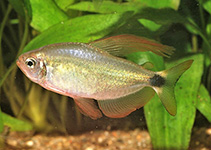| Family: |
Characidae (Characins; tetras), subfamily: Stethaprioninae |
| Max. size: |
3.22 cm SL (male/unsexed) |
| Environment: |
benthopelagic; freshwater; depth range 0 - 2 m |
| Distribution: |
South America: Brazil. |
| Diagnosis: |
Dorsal soft rays (total): 9-9; Anal soft rays: 23-26; Vertebrae: 32-32. This species is distinguished from all its congeners, except diastatos, elachys, heliacus, loweae, notidanos, peugeoti and the Hyphessobrycon species of the rosy-tetra group (sensu Weitzman & Palmer, 1997), by having the dorsal-fin elongated in mature males (vs. not elongated); differs from Hyphessobrycon species of the rosy-tetra group by the absence of a dark blotch on dorsal-fin (vs. presence); differs from the remaining Hyphessobrycon species by having two humeral blotches (vs. one in heliacus, notidanos, peugeoti, loweae; humeral blotch inconspicuous or absent in elachys, diastatus); differs from diastatos, elachys, otidanos, loweae by having a higher number of branched anal-fin rays 23-26 (vs.15-18 in diastatos; 16-20 in elachys; 17-20 in notidanos; 17-21 in loweae); from heliacus by having the pelvic fin not filamentous in adult males (vs. pelvic-fin filamentous), and by chevron-like dark markings along the midline of the body absent or inconspicuous (vs. present and conspicuous); differs from peugeoti by having a silvery to yellowish color in live mature males (vs. mature males red in life), and higher number of branched anal-fin rays, 23-26, modally, 25 (vs. 21-24, modally, 22) (Ref. 128639).
Description: D ii.9; A iv,23-26; pectoral I,10-12; pelvic I,7; gill rakers on first gill arch 17-18 (Ref. 128639). |
| Biology: |
Type locality of this species is a clear water river 40 m wide, 0.5-2 m deep, with swift current, rocky bottom, and reduced riparian vegetation, probably due to anthropogenic activities. Syntopic species included were Ancistrus sp., Characidium aff. zebra, Crenicichla pellegrini, Eigenmannia gr. trilineata, Farlowella amazonum , Gymnotus coropinae, Helogenes marmoratus, Hyphessobrycon sp., Leporinus maculatus, Moenkhausia comma, Moenkhausia collettii , Otocinclus mura, Pimelodella cf. howesi, Poptella compressa, Satanoperca jurupari and Tatia dunni. The stomach contents of the two paratypes included nematoids, chironomids larvae, unidentified vegetal fragments and sediments (Ref. 128639). |
| IUCN Red List Status: |
Not Evaluated (N.E.) Ref. (130435)
|
| Threat to humans: |
harmless |
Source and more info: www.fishbase.org. For personal, classroom, and other internal use only. Not for publication.
